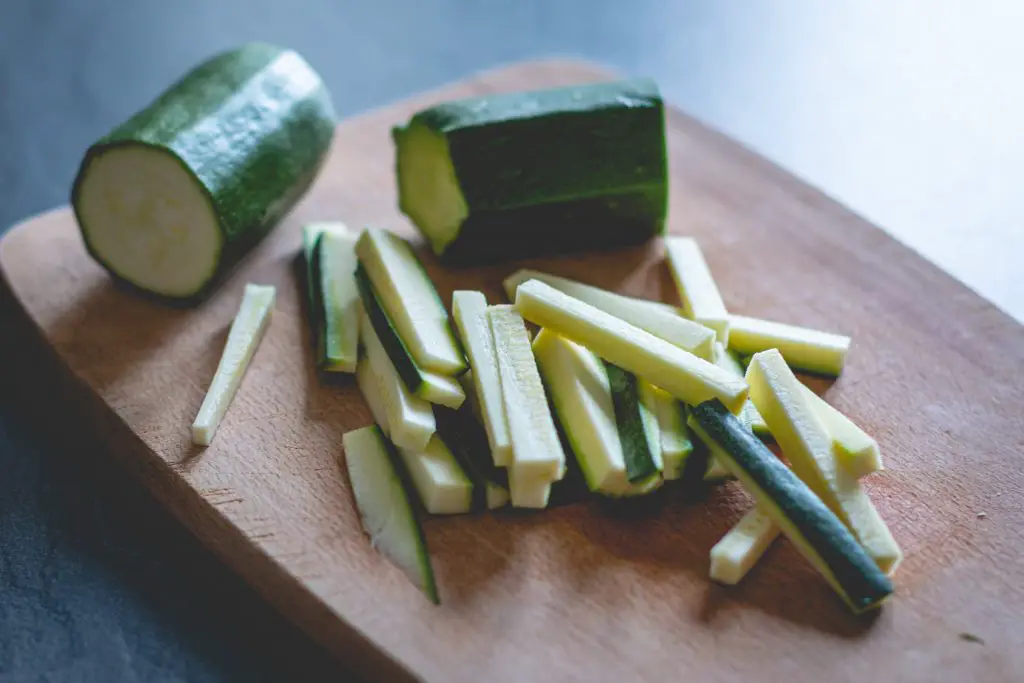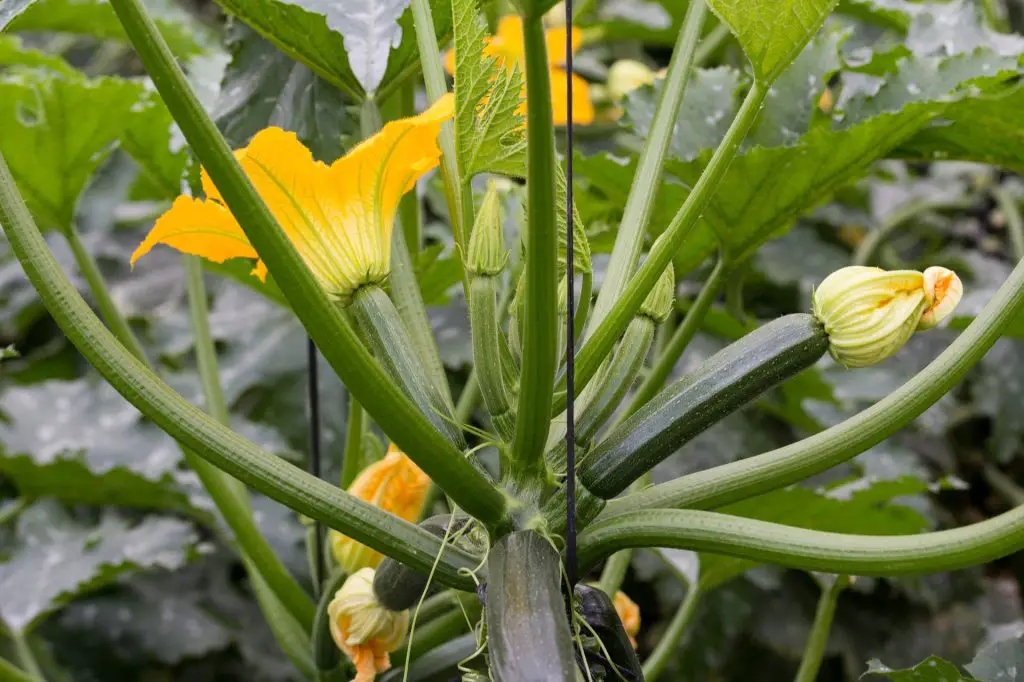Do You Need Two Zucchini Plants To Get Fruit? Zucchini is one of the most popular and prolific vegetables in the garden, however, zucchini plants take up quite a bit of space. So for those people that have a small garden, you may need to limit the zucchini plants to just one. But with only one plant will you still get fruit?
A zucchini plant planted by itself in a garden will produce fruit, a second plant is NOT required for cross-pollination. The reason for this is that zucchini plants are monoecious which means that they produce both male and female flowers on one plant. This characteristic allows the zucchini plant to self-pollinate which means a second plant is not required.
However, most zucchini varieties do benefit from the presence of a second plant as it increases the number of flowers in the general area which in turn increases the chance of pollination. But you can help things along by hand pollinating the flowers. How to do this is discussed later in the article.
How To Grow Zucchini
Zucchinis are one of the easiest and most reliable vegetables to growing in the garden. They are a prolific producer that once the plant gets going you will have zucchini coming out of your ears. At my house, which is a family of 5 with a large vegetable garden I only plant 3 or 4 plants every year. That is more than enough to supply the daily needs of the house, freezer enough for winter, make zucchini pickles, give some away, and still have some leftover.
To get started with zucchini they can either be grown from seed or purchased as a seedling from the local garden centre. The plants normally come in punnets containing 3 or 4 plants so you will only need to purchase one punnet, however, they are also extremely easy to grow from seed.
If you are growing zucchini from seeds it is best the plant them around 4 to 6 weeks before the last frost undercover, though it is possible to plant them earlier if you are prepared to transfer the seedling to a pot and continue to grow it undercover for a while, as zucchini is a frost-tender plant. The advantage of doing this is that it will provide an earlier harvest, but it has been my experience that you only gain a week or two at most from planting early.

Planting Seeds
When growing the plants from seeds it is best to use modular trays that are filled with a specific seed raising mixture that is ideal for growing seeds. It is advisable not to use soil from the garden for this purpose because garden soil will contain pathogens and weeds seeds that will compete with the zucchini seeds.
If you live in a cold region it will be necessary to supply additional heat to ensure that soil is sufficiently warm to allow germination to occur. This can be achieved by placing the tray in the interior of the house, however, as the heating can come on and off it is better to use a heated propagation tray.
Heated propagation trays provide a constant and controlled temperature that is ideally suited to grow seeds making it easy to grow seeds in even the coolest climates. They are also a relatively low-cost item that will last for many years, the unit we recommend is the iPower Heating Seed Starter Germination Kit, shown in the picture below largely because it has a vented humidity dome and is relatively inexpensive. Click on the link to see the current price on Amazon.

Once the trays is filled with soil it is advisable to plant 2 seeds per cell at a depth of approximately half an inch (1 cm). The seeds need to be watered regularly to ensure that the soil remains moist.
Typically seedlings will emerge after a week or two and then will require a further 2 to 4 weeks of growing time before they are ready to be planted out into the garden.
Planting Zucchini In The Garden
It is advisable to only plant zucchini out into the garden once any risk of frost has passed. If the weather remains too cold it may be necessary to put the plant into a pot can keep it indoors until the weather improves.
When selecting a location it is important to ensure that it gets as much light as possible, at least 6 to 8 hours per day is a minimum. In terms of soil conditions, zucchini plants are heavy feeders that require rich moist soil that has plenty of organic matter. To achieve this it is advisable to add a lot of compost to the soil.
Plants should be spaced around 3 ft apart (90 cms) to provide plenty of room for them to grow. Additionally, it is important to provide some protection against slugs and snails as zucchini plants are particularly susceptible to attack in the first few weeks after transplanting in the garden.
As zucchini likes relatively warm conditions, it helps to protect the plants from the cold in spring by using a row cover particularly if you live somewhere like the UK where the summers don’t get that hot and the weather can be a little unpredictable.
If you currently don’t have a row cover that can be purchased from Amazon. The product we recommend is the Growsun Garden Tunnel Plant Cover because it is relatively tall and has hoops that can be anchored deeply into the ground which allows it to resist wind. The product is shown in the image below.

Once the plant becomes established there is relatively little to do apart from mulching and watering, however, the plant can sometimes benefit from hand pollination which can boost the yield.
How To Hand Pollinate Zucchini Flowers?
Hand pollination is an easy process to undertake that only takes a few minutes to complete. It is recommended that you repeat this process a couple of times over the period of a few weeks to make 100% sure that pollination has occurred.
To complete this process you will need a fine artist paintbrush, however, if you don’t have one lying around you can use the more destructive, but nonetheless effective method, of removing a male flower from the plant. The male flower can then be moved around the plant and used to pollinate the female flowers.
When using a brush start by going to a male flower and then gently brushing around the yellow tip of the flower until pollen collects on the brush. The pollen is yellow in color and you should be able to see the grains clearly on the end of the brush.
Then use the brush to transfer the pollen to the female flower by gentle brushing the center of the flower. This process should then be repeated for all the other flowers on the plant.
How Do You Tell The Difference Between Male And Female Flowers?
Zucchini flowers are quite easy to tell apart once you know what you are looking for. Female flowers that the ones that sit on the end of developing fruit. Once the fruit reaches a reasonable size the flowers will open up ready for pollination.
If pollination occurs the fruit will continue developing, whereas an unpollinated fruit will die back. If there are lots of underdeveloped fruit dying back that is an indication the plant will benefit from some hand pollination. The photograph below shows a number of female flowers in the different stages of development.

Harvesting Zucchini
Zucchini fruits have the potential to get very large, they have been known to get up to 2 to 3 feet in length if they are left on the plant too long. Additionally, at this size the skin and seeds of the fruit can become extremely hard which makes it quite inedible.
Zucchinis are best harvested when they are relatively small, around 6 to 8 inches. At this size the skin is soft and the seeds are immature. You will find that early in the season it is easy to keep on top of the picking of fruit, however, once the plants really get going zucchini appear extremely quickly and increase in size rapidly. So you must pick the fruit every couple of days to get the most out of the plant.
